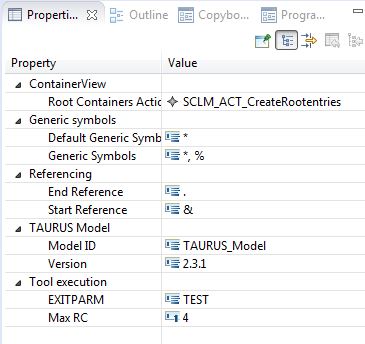





Global settings that apply to the complete application can be defined under the application options.
One attribute of the application options is Version. At run time, the version of the local AWM model is compared with the version entry in the Master Configuration file. See Master Configuration for more information.
The attributes Start Reference and End Reference are used for parsing variable references. See Variable References for more information. By default these have the values “&” and “.”.
In addition, the tool execution can be controlled from the application options. The maximum return code that the tool can return without its execution being interpreted as “failed” is specified in the attribute MaxRC. Failed tools end with an error message, and prevent the execution of further tools in the tool sequence of the action.
With the EXITPARM attribute, the administrator can define a parameter value for an initial exit called before an ISPF tool is started. This can be used, for example, for the dynamic allocation of additional libraries to ensure that the tool attachment runs in a test environment. See the description of Exit TAUTOXA1 in ISPF Exits for more information.
The Root Containers Action attribute can be used to refer to an action which returns the root elements used to build up the first hierarchical view of the application which are visible in the Tree View. The referenced action descriptor must return an element list whose match name property typically references a container element type. See Table Structure for more information.
| Relationship | Cardinality | Description |
|---|---|---|
| Has_Specific_Attribute | 0..4 | Relationship to a specific attribute. |


The application options of the SCLM model have a reference to the application specific attribute SYSLIB. This is used in the Micro Focus COBOL and PL/I editor to find and download COBOL copybooks or PL/I includes in a z/OS remote edit scenario. In this model the value of the application specific property SYSLIB is a reference to a AWM model property. This allows allocating the SYSLIB concatenation dynamically. The SYSLIB concatenation is returned by an ISPF tool which is called in a remote edit action just before the edit tool is called.
| Attribute | Value | Description |
|---|---|---|
| Container View: | ||
| Root Containers Action | SCLM_ACT_CreateRootentries | Reference to the SCLM action which returns the SCLM projects. |
| Generic Symbols | ||
| Default Generic Symbol | * | Asterisk is used as default generic symbol in the SCLM application. |
| Generic Symbols | *,% | Asterisk and % are interpreted as generic symbols in the SCLM application. |
| Referencing: | ||
| End Reference | . | Dot is used to terminate a property reference in the SCLM application. |
| Start Reference | & | & is used to start a property reference in the SCLM application. |
| TAURUS Model: | ||
| Model ID | TAURUS_Model | For internal use only; should not be changed. |
| Version | 2.3.1 | Version number of this instance of the SCLM application. By changing the version number the AWM model administrator can trigger the local copy of the SCLM application to be replaced by the new instance from the location specified in the master configuration file. |
| Tool execution: | ||
| EXITPARM | TEST | The value test in the EXITPARM option is passed to the REXX procedure TAUTOXA1 and can be used, for example, to allocate a test environment when tools from this SCLM application are called. |
| Max RC | 4 | If any tool of the SCLM application returns with an RC higher than 4, the tool execution is interpreted as failed and the whole action is terminated with an error message. |


